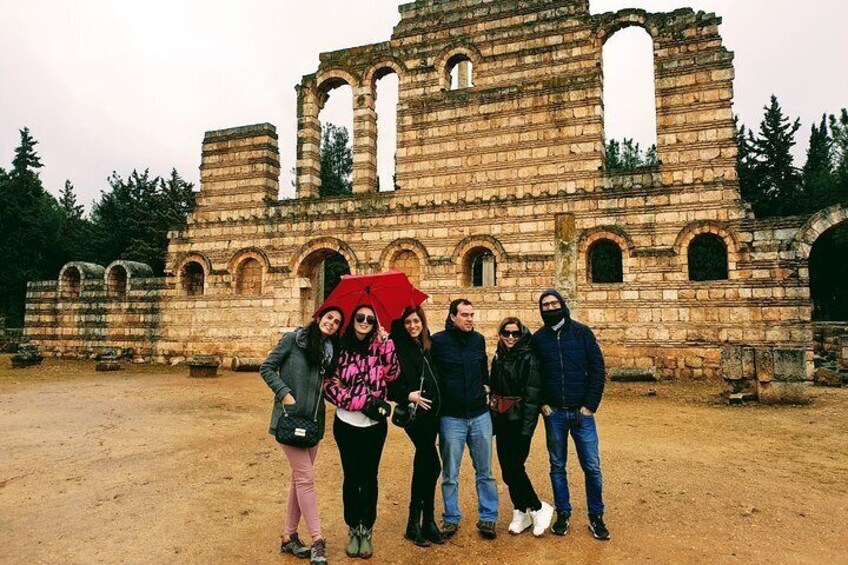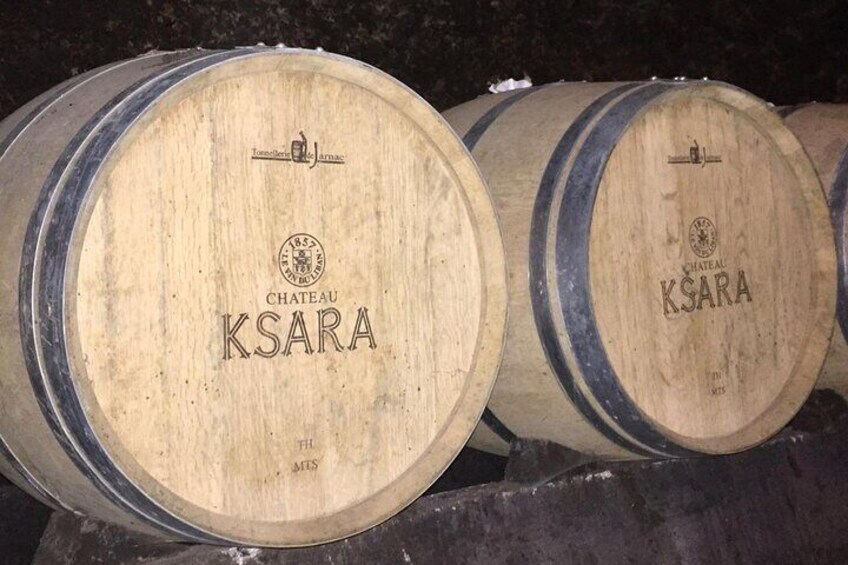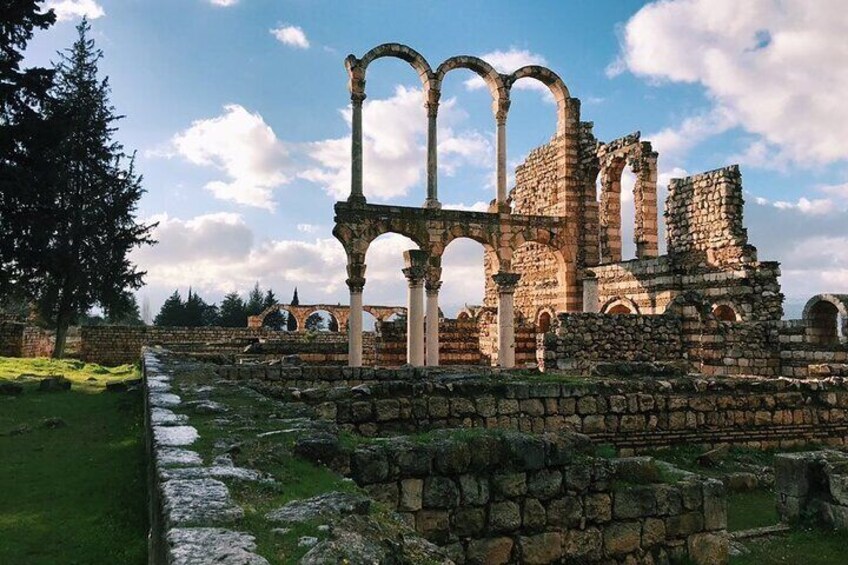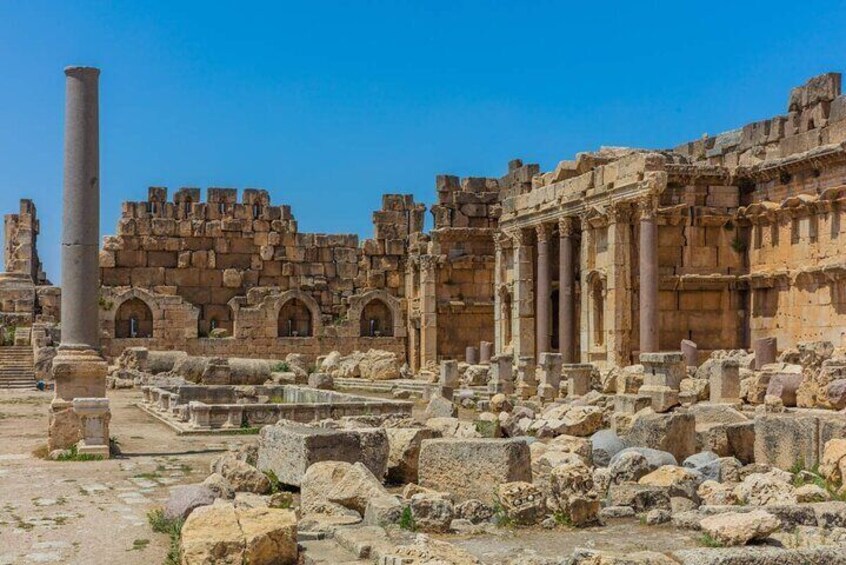




Sightseeing all-inclusive Small group Tour to Baalbek, Anjar and Ksara
By Lebanon Tours
Free cancellation available
per adult
Features
- Free cancellation available
- 8h
- Mobile voucher
- Instant confirmation
- Selective hotel pickup
- Multiple languages
Overview
The Roman Empire of Baalbek is a surviving wonder of the ancient world. Experience it in style, without the haggling, on this small group tour. Your local guide will introduce you to the three great temples of Jupiter, Bacchus and Venus. Along the way, visit the unique Umayyad site founded by Caliph Walid I at the beginning of the 8th century. Afterward, sample Lebanese authentic wine at one of the oldest and famous wineries in Lebanon. Capture timeless pictures, and enjoy a Lebanese lunch. A door-to-door visit in a small group provides an intimate experience.
Activity location
- Baalbek
- Baalbek, Beqaa Governorate, Lebanon
Meeting/Redemption Point
- Baalbek
- Baalbek, Beqaa Governorate, Lebanon
Check availability
Sightseeing all-inclusive Small group Tour to Baalbek, Anjar and Ksara
- 8h
- English
Pickup included
Starting time: 8:30am
Price details
$99.00 x 1 Adult$99.00
Total
What's included, what's not
- Entry/Admission to Anjar
- Lunch
- Hotel Pick up & Drop off
- Air-conditioned vehicle
- Professional Guide
- Entry/Admission to Baalbek
- Entry/Admission to Chateau Ksara - Wine Tasting
- Gratuities
Know before you book
- Specialized infant seats are available
- Suitable for all physical fitness levels
Activity itinerary
Baalbek
- 1h 30m
Baalbek, is home to the Baalbek temple complex which includes two of the largest and grandest Roman temple ruins: the Temple of Bacchus and the Temple of Jupiter. It was inscribed in 1984 as an UNESCO World Heritage site.
This Phoenician city, where a triad of deities was worshipped, was known as Heliopolis during the Hellenistic period. It retained its religious function during Roman times, when the sanctuary of the Heliopolitan Jupiter attracted thousands of pilgrims. Baalbek, with its colossal structures, is one of the finest examples of Imperial Roman architecture at its apogee.
Temples of Baalbek
- 1h 30m
- Admission ticket included
The complex of temples at Baalbek is located at the foot of the south-west slope of Anti-Lebanon, bordering the fertile plain of the Bekaa at an altitude of 1150 m. The city of Baalbek reached its apogee during Roman times. Its colossal constructions built over a period of more than two centuries, make it one of the most famous sanctuaries of the Roman world and a model of Imperial Roman architecture. Pilgrims thronged to the sanctuary to venerate the three deities, known under the name of the Romanized Triad of Heliopolis, an essentially Phoenician cult (Jupiter, Venus and Bacchus).
Temple of Jupiter
- 30m
- Admission ticket included
The Temple of Jupiter is a colossal Roman temple, the largest of the Roman world, situated at the Baalbek complex in Heliopolis. The temple served as an oracle and was dedicated to Jupiter Heliopolitanus.
It is not known who designed the temple, nor exactly when it was constructed. Work probably began around 16 BC and was nearly complete by about ad 60. It is situated at the western end of the Great Court of Roman Heliopolis, on a broad platform of stone raised another 7 m (23 ft) above the huge stones of the foundation, three of which are among the heaviest blocks ever used in a construction.
It was the biggest temple dedicated to Jupiter in all the Roman empire. The columns were 30 meters high with a diameter of nearly 2.5 meters: the biggest in the classical world. It took three centuries to create this colossal temple complex.
Temple of Bacchus
- 30m
- Admission ticket included
The Temple of Bacchus is part of the Baalbek temple complex located in the Bekaa Valley, Lebanon. The temple complex is considered an outstanding archaeological and artistic site of Imperial Roman Architecture and was inscribed as an UNESCO World Heritage site in 1984. The Temple of Bacchus is one of the best preserved and grandest Roman temple ruins; its age is unknown, but Its fine ornamentation can be dated to the second century CE.
Temple of Venus in Heliopolis
- 30m
- Admission ticket included
The Temple of Venus was built in the third century. Built on a horseshoe-shaped platform, it consists of a circular shrine with a square entrance that is almost as big. The outer façade of the shrine is graced by five niches, which means that there is not a single square wall. In the niches are representations of doves and shells, which has been taken as evidence that the shrine was dedicated to Venus.
Sayyida Khawla Shrine (Pass by)
The Mosque of sayeda Khawla in Baalbek, Lebanon is erected on the site where Sayyida Khawla, the daughter of Imam al-Hussein, the grandson of the Prophet Muhammad, is believed to have been buried. People of Baalbek believe that when the caravan of captives of Karbala passed Baalbek, The daughter of Imam al-Hussein, called Khawla passed away and was buried there.
Stone of the Pregnant Woman
- 15m
The Stone of the Pregnant Woman is a worked Roman monolith in Baalbek, Lebanon. Together with another ancient stone block nearby, it is among the largest monoliths ever quarried. The two building blocks were presumably intended for the nearby Roman temple complex, and are characterized by a monolithic gigantism that was unparalleled in antiquity.
Anjar
- 45m
The city of Anjar was founded by Caliph Walid I at the beginning of the 8th century. The ruins reveal a very regular layout, reminiscent of the palace-cities of ancient times, and are a unique testimony to city planning under the Umayyads.
Umayyad Ruins of Aanjar
- 45m
- Admission ticket included
The Umayyad Ruins of Aanjar bears outstanding witness to the Umayyad civilization and a good example of an inland commercial centre, at the crossroads of two important routes: one leading from Beirut to Damascus and the other crossing the Bekaa and leading from Homs to Tiberiade. The site of this ancient city was only discovered by archaeologists at the end of the 1940s.
The ruins of Anjar include the walls of the Umayyad palace, harems, a mosque, the great palace of the Caliph, thermal baths, and many pillars which include some elements of the Roman architectural style.
Chateau Ksara
- 1h
- Admission ticket not included
Château Ksara is a wine company in The Beqaa Valley Lebanon. Founded in 1857 by Jesuit priests. Château Ksara developed the first dry wine in Lebanon. Château Ksara produces approximately 3 million bottles annually. Its wines are exported to over 40 countries.
Location
Activity location
- Baalbek
- Baalbek, Beqaa Governorate, Lebanon
Meeting/Redemption Point
- Baalbek
- Baalbek, Beqaa Governorate, Lebanon
Best Deals on Things to Do
Experience the wonders of the world up close with great deals on things to do near and far. We offer one-of-a-kind activities that allow you to explore Baalbek your way. Whether you love nature, culture, food, or a bit of adventure, we have the perfect activity for you.